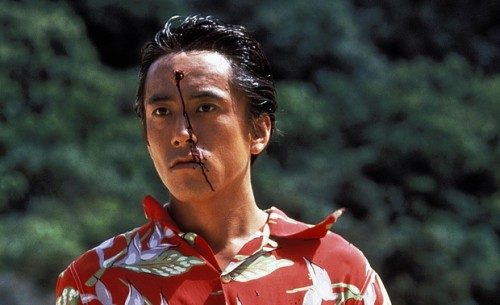Criterion Prediction #26: Sonatine, by Alexander Miller
Title: Sonatine
Year: 1993
Director: Takeshi ‘Beat” Kitano
Cast: Beat Takeshi, Aya Kokumai, Tetsu Watanabe, Masanobu Katsumura, Susumu Terajima and Aya Kokumai
Synopsis: Aging yakuza lieutenant Murakawa (played by the film’s writer, director and producer) has grown weary of his way of life and finds his faction of fellow henchmen used as pawns in an attempt to quell a turf war between two rival clans. Traveling from Tokyo to Okinawa to settle what seems like a trivial dispute, Murakawa and his soldiers become targeted in an assassination attempt. The surviving crew hold out in a beachside house to let the dust settle and figure out why they have been targeted.
Critique: A little intel on yakuza films: The bulk of the genre comes from the Ninkyo Eigo (aka chivalry stories) serials centering on lone yakuza (predominantly set in the Meiji era, 1880’s – 1910) who abide by their code of honor while conflicted with righting wrongs and their code of ethics. This movement went wayward with the free-form aesthetics of Seijun Suzuki’s many madcap exploits (many of which are featured in the Criterion Collection) with films like Tokyo Drifter, Branded to Kill and Take Aim at the Police Van. Kinji Fukasaku was central in ushering in the Jitsurogu style – gritty, realistic, often based on real stories where honor and morality were frequently absent. Fukasaku’s eight-entry saga Battles Without Honor and Humanity would be most emblematic of the Jitsurogu type. Nevertheless, his entire oeuvre is consistently unrelentingly ferocious. Takeshi Miike refreshed the genre during his early V-cinema days with his Black Society Trilogy; Beat Takeshi reformulated the genre unlike anyone had before or after.
On the surface, Sonatine sounds like a pretty familiar tale of a turf war gone awry but Kitano suffuses his film with deadpan, pitch black humor, deliberate pacing, visual gags, ironic framing devices, and unexpected bursts of stylized violence. Kitano’s style is difficult to explain but impossible to miss. His approach is best described as a melding of the impassive humor of Jim Jarmusch, the subtle timing and pragmatism of Howard Hawks, and the dutiful existential tendencies we’d see from the stoic gangsters in a Melville film.
Sonatine follows a three act structure; the Okinawa skirmish, the beachside hideaway and the elegiac finale. Kitano’s timing and execution of violence is as expressionistic and stylized as it is economic and blunt. Favoring static compositions Kitano’s characters maintain expressionless, fixed gazes, sometimes directly into the camera even in situations of brutal violence.
Kitano’s structural arcs are carefully delineated by the film’s distinct tonal shifts. While the first act is turbulent, the second is mostly comedic; Murakawa and his cronies play games on the beach, blast roman candles at each other, dig traps in the sand and shoot cans off each other’s heads. While the setting is a coastal remove in Japan, this is the closest thing I’ve seen to Dean Martin, Ricky Nelson, and John Wayne singing and hanging around in Rio Bravo. Takeshi Kitano’s visual and technical instincts are consistent, never does he overplay his hand, nor does he veer towards self-indulgence, he’s not interested in “style for style sake” but he’s unafraid of staunch artistry. Joe Hisaishi’s score is another highlight. His working relationship with Kitano is on par with Sergio Leone and Ennio Morricone. Kitano’s enigmatic career is somewhat akin to Orson Welles, like Welles Kitano is a man of many talents, his career as an actor and a comedian assuredly lend to his singular directorial style, he’s also a mean tap dancer. Sonatine might be the most unlikely yakuza film ever made, but it’s also one of the best.
Why it Belongs in the Collection: Criterion obviously has great affection for yakuza films but their selection is limited to sixties studio films, many of which are directed by Seijun Suzuki, who is wholly enjoyable but a bit overrated considering how many of his films appear in the collection.
If you were to introduce someone to Takeshi Kitano’s directorial work, Sonatine is a perfect jumping off point. His earlier directorial efforts, Boiling Point, and Violent Cop are admirable but Sonatine shows how Kitano refined his now trademark style. More importantly, in terms of their selection, the inclusion of Sonatine would expand the timeline of yakuza films as well as provide more variety, taking the genre closer to the end of the 20th century.
Since Criterion hosts over a dozen yakuza films, it might seem bratty to pine about wanting more but it goes to show just how expansive this cultural genre is.
I don’t know how coveted the rights are to Quentin Tarantino’s Rolling Thunder Pictures but it was the only way to find Wong Kar-wai’s Chungking Express on video until the Criterion release. However, this might not be the best example, seeing as Chungking Express is one of the white whales of Criterion’s OOP line. Short lived but well intended; Rolling Thunder Pictures didn’t blow up the way it could have, but Quentin succeeded in introducing an excellent film among others to the N. American market. However, it was released as a companion to Kitano’s 2003 Zatoichi remake on DVD; where it looks more like a bonus feature than anything else. Takeshi Kitano is easily one of the most fascinating and creative directors working today whose presence has been long too overlooked in the home video world. Plus, we’re still plagued with secondary DVD’s, second region bootlegs and VCD’s.



























